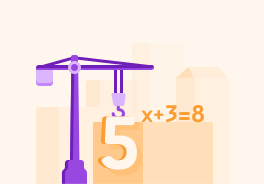YOU ARE LEARNING:
Algebraic Fractions: Addition and Subtraction

Algebraic Fractions: Addition and Subtraction
Adding and subtracting algebraic fractions together allows us to express them as a single fraction.
Adding and subtracting algebraic fractions is much like adding and subtracting numerical fractions.
The objective is to be able to write them as a single fraction.
Adding fractions is simple when the denominators are the same, we just add the numerators. What is x+15+x+14?

Subtraction uses the same principle, what is n3−n1+n?

What happens when the denominators are not the same?
5x+6x
Just like with numerical fractions, the first step is to find a common denominator. What does this mean?

Find the lowest common denominator for 5x+6x.

We can't just change the denominator as this would change the value of the fraction.
We need to multiply the numerator in the same way as the denominator.
Our first fraction is 5x, and we have multiplied top and bottom by 6
5×6x×6=306x
What does the second fraction 6x become to give it a denominator of 30?

We have converted our fractions with different denominators to fractions with common denominators and can add them together as before. What is 5x+6x=306x+305x?

Nice! The final answer is 3011x
This can't be simplified any further.
What is 4x+7x?

Find the sum 3b2+2b1
We can apply the same principles when the denominator contains a letter.
Let's work through this one 3b2+2b1
What is the common denominator? 3b2+2b1

We then multiply both fractions to make 6b the denominator. For the first fraction this is 3b×22×2=6b4

Now we can add our fractions. 6b4+6b3

Well done - you've solved a fraction with an algebraic denominator!
The final answer is 6b7
What is 3x4+5x2?

x+16+x+4x
Let's try something a little harder. We need to take it one step at a time.
Let's try x+16+x+4x.
We use the same principle.
We just need to be careful with the denominators as they each have two terms.
First we need to find the common denominator. This is found by multiplying the denominators together, make sure to use brackets!

Our common denominator is (x+1)(x+4). We must multiply the numerator and denominator of the first fraction by (x+4).
This makes the first fraction (x+1)(x+4)6(x+4).
We have converted our first fraction to (x+1)(x+4)6(x+4). What does the second fraction become?

We can now add the fractions together. (x+1)(x+4)6(x+4)+(x+1)(x+4)x(x+1)

We now have a very busy fraction (x+1)(x+4)6(x+4)+x(x+1)!
We can multiply out the brackets in the numerator to simplify it a little.
Focusing on the numerator, multiply out and simplify 6(x+4)+x(x+1).

We can leave this as our final answer. Well done!
x+16x+4x=(x+1)(x+4)x2+7x+24
Summary! Add algebraic fractions in the same way as numerical fractions.
Find the common denominator first. For 65x+3x5 the common denominator is 6x.
Cross multiply the fractions to express them in terms of the common denominator.
65x+3x5 =6x5x×x+6x5×2 =6x5x2+6x10
With a common denominator we just add the numerator.
6x5x2+6x10 =6x5x2+10
Summary of a more complex addition: x+2x+x−48
First cross multiply to get the common denominator.
(x+2)(x−4)x(x−4) + (x+2)(x−4)8(x+2)
Add the numerators
(x+2)(x−4)x(x−4)+8(x+2)
Multiply out the numerator
(x+2)(x−4)x2−4x+8x+16)
Gather the like terms together for the final answer
(x+2)(x−4)x2+4x+16
